
Strathearn or Strath Earn, also the Earn Valley, is the strath of the River Earn, which flows from Loch Earn to meet the River Tay in the east of Scotland.

Pittenweem Priory was an Augustinian priory located in the village of Pittenweem, Fife, Scotland.
Saint Fillan, Filan, Phillan, Fáelán or Faolán is the name of an eighth century monk from Munster, who having studied at Taghmon Abbey, traveled to Scotland and settled at Strath Fillan.

Saint Fillan was a sixth-century Scottish monk active in Fife. His feast day is 20 June.
The Abbot of Paisley was the head of the Cluniac monastic community of Paisley Abbey and its property. The monastery was founded as a priory at Renfrew in 1163, but moved to Paisley in 1169. It became an abbey in 1219. The founder was Walter fitz Alan, Seneschal (Steward) of Scotland. The line of abbots ended when it was turned into a secular lordship for Lord Claud Hamilton in 1587/1592. The following is a list of abbots and commendators:
Strath Fillan is a strath in west Perthshire named after an 8th-century Irish hermit monk, later canonised as Saint Fillan. Located in the region was once Strath Fillan Priory, an early 14th century foundation, later destroyed by the Campbells in the name of Calvinism.

The Abbot of Inchaffray, before 1221 Prior of Inchaffray, and then by the end of the 15th century, the Commendator of Inchaffray, was the head of the community of Augustinian canons of Inchaffray Abbey and their lands. Inchaffray is in Strathearn, in southern Perthshire, Scotland. The house was founded by Gille Brigte (Gilbert), mormaer of Strathearn in 1200 as a priory and was elevated to an abbey in 1221. By the late 15th century the monastery was becoming secularized. and after the resignation of Abbot George Mureff (Murray) in 1495, Laurence, Lord Oliphant, took over as commendator and thereafter it was held by commendators. It was turned into a secular lordship for Commendator James Drummond, Lord Maddertie, but the final formalization of the lordship did not come until 1669, when it was given to William Drummond.
The Prior of Loch Leven was the head of lands and of the community Augustinian canons of St Serf's Inch Priory, Loch Leven. There was a Scottish Céli Dé establishment there in the first half of the 12th century, allegedly found by Bruide, son of Dargart, King of the Picts (696–706). When the Augustinian priory was founded in 1150, the Scottish monks were absorbed into the established and those who refused to join were to be expelled. Not all of the priors are known. The most famous prior undoubtedly was the chronicler, Andrew de Wyntoun. Following more than four centuries of Augustinian monastic life and the resignation of the last prior, the Protestant king, James VI of Scotland, granted the priory to St Leonard's College, St Andrews.
The Prior of Beauly was the head of the Valliscaulian monastic community and lands of Beauly Priory, Beauly, Inverness-shire. It was probably founded in 1230. It became Cistercian on April 16, 1510. The following are a list of priors and commendators:
The Prior of Inchmahome was the head of the community of Augustinian canons at Inchmahome Priory, on Inchmahome in the Lake of Menteith, in Highland Stirlingshire, Scotland. The following is a list of priors and commendators:
The Prior of Oronsay was the Religious Superior of Oronsay Priory, a community of canons regular on the island of Oronsay, Inner Hebrides, off the coast of Scotland. It was in existence by 1353, perhaps founded by John of Islay, Lord of the Isles.

The Abbot of Fearn was the head of the Premonstratensian monastic community of Fearn Abbey, Easter Ross, Scotland. The Abbey was founded by canons from Whithorn Priory in Galloway, with the patronage of Fearchar mac an t-Sagairt, mormaer/earl of Ross. The foundation took place in the 1220s, according to the two distinct foundation dates given in the sources, either in 1221 or in 1227. Until about 1238, the Abbey was located at Fearn, near Edderton, but it was moved to the Tarbat parish in that year and known thereafter as "nova Furnia". Despite the fact that the head of Whithorn Priory was a prior and Fearn an abbot, Fearn seems to have remained subordinate to Whithorn until at least the end of the 14th century, and even in 1440 Abbot Fionnlagh II was confirmed by the prior of Whithorn.The reason for this is that Whithorn was a cathedral priory; the nominal head of its community was the bishop, but its actual head was the prior, as was the common use in England at places like Durham and Carlisle, but this was not usual in Scotland. In these circumstances the cathedral prior had the same rights as an ordinary abbot.

Strath Fillan Priory was a small Augustinian Priory based at Strath Fillan in Argyll. It seems to have been founded in 1318 by Robert I, King of Scots, and given to the canons of Inchaffray Abbey in order to properly celebrate St Fillan, a saint popular with the 14th century kings of Scotland. It had royal patronage after the Scottish Reformation.
The Prior of May then Prior of Pittenweem was the religious superior of the Benedictine monks of Isle of May Priory, which later moved to the mainland became called Pittenweem Priory. The priory was originally based on the Isle of May, but was moved by 1318 to its nearby mainland site of Pittenweem, Fife, passing from the overlordship of Reading Abbey (Benedictine) to St Andrews Cathedral Priory (Augustinian). The following is a list of priors and commendators:
The Prior of Coldingham was the head of the Benedictine monastic community of Coldingham Priory in Berwickshire, Scotland. The priory was founded in the reign of David I of Scotland, although his older brother and predecessor King Edgar of Scotland had granted the land of Coldingham to the Church of Durham in 1098 AD, and a church was constructed by him and presented in 1100. The first prior is on record by the year 1147, although an earlier foundation is almost certain. The monastic cell was a dependent of Durham until the 1370s, and in 1378 King Robert II of Scotland expelled the Durham monks; for the following century the cell had two priors, one chosen by Durham and one chosen by the Scots. It became a dependent of Dunfermline Abbey. It was subject to increasingly secular control from the late 15th century into the 16th century.
The Prior of Pluscarden was the head of the monastic community and lands of Pluscarden Priory, Moray, Scotland. The Priory was founded in 1230 by King Alexander II of Scotland for the Valliscaulian Order. In March 1454 it incorporated the foundering neighbouring establishment of Urquhart Priory and became a dependency of Dunfermline Abbey, whence it became Benedictine. The following are a list of abbots and commendators:
The Archdeacon of Caithness was the only archdeacon in the Diocese of Caithness, acting as a deputy of the Bishop of Caithness. The following is a list of known historical archdeacons:

Beinn Challuim is a mountain in the Breadalbane region of the Scottish Highlands. It is east of the village of Tyndrum, in the Forest of Mamlorn, an ancient deer forest at the northern edge of Loch Lomond and the Trossachs National Park. It is a Munro with a height of 1,025 metres (3,363 ft).

The Dewar na Ferg is a branch of the Scottish Clan Dewar, originating in Perthshire. They are best known for their claim to be the rightful keepers of Saint Fillan's holy relics; especially the Stone (Ferg).

St. Fillan's Crozier is an 8th century Insular crozier crook traditionally associated with the Irish monk St. Fillan, who lived in the eighth century at Glendochart in Perthshire, central Scotland. Only the crook survives; the staff was lost at an unknown date. Sometime around the late 13th century it was encased in the Coigreach, a crosier-shrine of similar size and form built as a protective case, made from silver, gold and rock crystal and dating from the late 13th century, with additions c. the 14th or 15th centuries. The Coigreach was rediscovered in the mid-19th century by the archaeologist Daniel Wilson, who opened it and found St. Fillan's Crozier inside.








